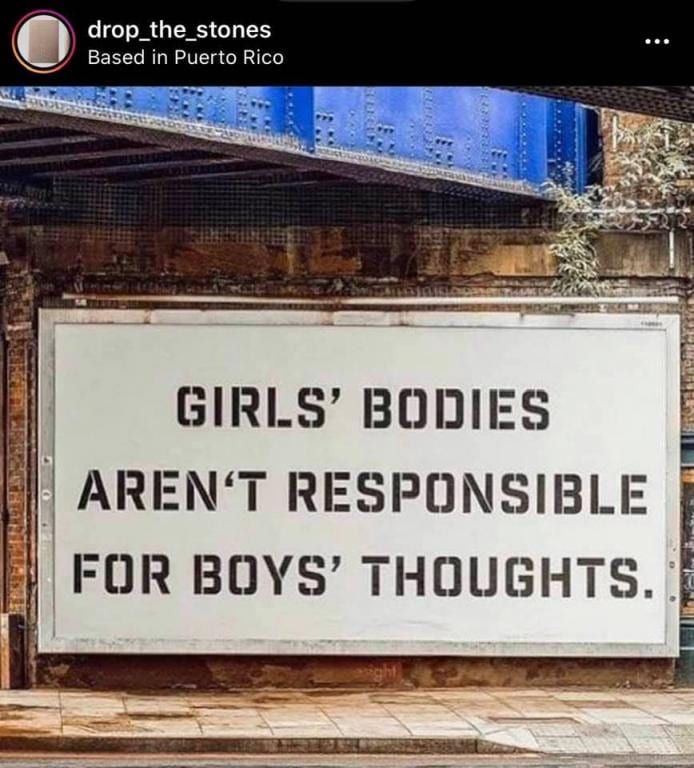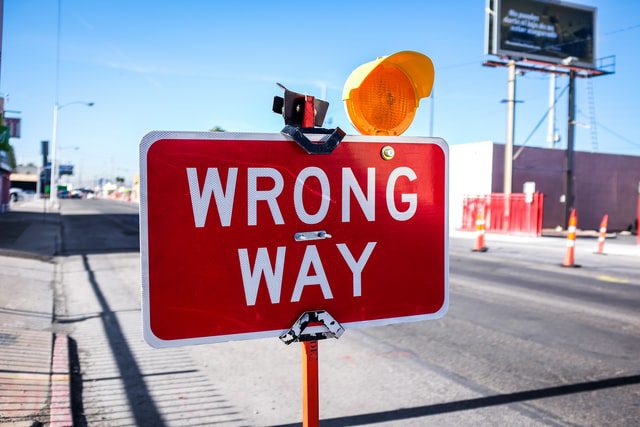
I think I am still surprised when others express narrow views of sexuality, despite how common it is. I may live in such a shielded bubble that when I step outside of it to confront the harsh reality, it kind of slaps me in the face. I mean, I still turn the other cheek, but the spontaneity of it all still rouses an initial reactionary defense.
A meme that was shared by a friend roused reactionary defenses of purity and modesty ideologies.
Girls’ bodies aren’t responsible for boys’ thoughts.
Indeed, a girl’s body is not responsible for a boy’s thoughts. But the question I have is this: Why does everyone surmise that all boys have lurid, sexual thoughts about girls? Isn’t that selling our youth a little short? Why are we putting our lens of the world atop of their lens? Do they see the world as we do? The most obvious answer is “no.” Our children do not see the world as we do. They have not created their own sexual context around their reality, because they aren’t having sex and most parents are not teaching them about it. They also have not embodied their sexual identity, because at adolescence, they are just coming into understanding what that phrase actually means. We must remember; we didn’t understand most of what was taking place in our minds or in our bodies when we were maturing. Why do we expect that our children do?
This meme created quite a stir, as they do on social media forums. Unsurprisingly, it was mostly women vocalizing dissent against what the meme was articulating. I say unsurprisingly because women are often harshest against other women, especially in keeping step with “admonishing modesty in young women.” Women believe they are doing one another favors when they critique another women’s length of a skirt, cleavage reveals, or ass dimensions and curvature. Women believe it is their duty to take other women under their wings and educate them on the need for dressing like a nun.
Nonetheless, it was astounding to see the number of women blaming other women (and young girls) for whatever potential evil could grow from any given male at any given time. Of course, there were men offering their narrow views as well, but such is the case when we have patriarchal, celibate influence over our society. Blame, however, seemed to be the overarching theme within the comments.
Women blame other women for men’s thoughts. Women blame other women when men rape women. Women blame other women when men cheat. Women blame other women when men stay. Women blame other women when women make another woman feel insecure.
Insecurity breeds scapegoats. And women, while attempting to act in the defense of women, objectify women far more harshly than any man does in a temporal moment of alleged “lusting” over an image. Women, claiming scripture as their authority, clobber other women’s confidence and security in sexuality out of a projection of their own internal struggles. Is that really what Jesus would do, ladies? Would Jesus ask you to objectify an image of women in such a way that you deem her “slutty”, “a whore”, whorish”, “asking for it”, and more?
I have to ask, what’s more objectifying? A man taking a moment to pause and look at a woman dressed attractively and thinking “she’s hot!” and then going about his day, or a woman looking at the same woman who thinks to herself “she must be a slut” or, “she must really need attention because she has daddy issues.”? If I could choose which kind of objectification I would subject myself to, it would be a man appreciating what God created in the form that I embody over a woman reducing me to the lowest of terms simply because my cleavage is revealed.
Sure, Jesus said a few things about lust, but none of that had to do with reducing a woman.
You have heard that it was said, ‘You shall not commit adultery.’ But I tell you that anyone who looks at a woman lustfully has already committed adultery with her in his heart. If your right eye causes you to stumble, gouge it out and throw it away. It is better for you to lose one part of your body than for your whole body to be thrown into hell. (Matthew 5:27-30 NIV)
Yet, in proceeding text, he says, “You have heard that it was said, ‘Eye for eye, and tooth for tooth. But I tell you, do not resist an evil person. If anyone slaps you on the right cheek, turn to them the other cheek also.” (Matt. 5:38-40). Is it possible that Jesus was being a little dramatic in the former verse when compared to the latter? Why would Jesus tell people to gouge their own eyes out if they sin, but then suggest that one turns the other cheek to allow another harm you, so you don’t harm them in return? Which is it? Harm the self but not others? Gouge our own eyes out if we stumble, but do nothing if another causes us to stumble?
Perhaps the answer lies in understanding how adulterers were treated during that time. Perhaps Jesus was cautioning people to not be so harsh with judgments and criticisms unless we are just as harsh and critical with ourselves?
Things to consider.
It was a man who sought to label woman as temptress out of his own internal misunderstanding of his own natural human sexuality—this we know thanks to history. But I would like to point out the notion that it is women who have made the feminine mystique a sport. Men may have reduced us biblically as an object in desperate need of masculine molding and forming. But it is women who continue to rank other women in a transactional sense. It is women who look at other women and judge her as an object and reduce her overall worth because she doesn’t have enough clothes on.
The truth is if we really want to utilize scripture to make a case for what God deems as acceptable, let us use Genesis 2:25. Adam and his wife were both naked, and they felt no shame. Were we not created naked? Is our natural state not nudity without shame? Did that not take place prior to “original sin” or the bite of the fig? Before humankind was tempted, before the choice to eat from the Tree of Knowledge of Good and Evil, we were naked and unashamed. What happened?
We fell for the lie of lack, the lie of separation, and the lie that something was wrong with who we are in our present form. That’s the sin. So, to reintegrate and transform those lies into loving truths, we must find our way back to that pre-Garden mentality, where nudity wasn’t shameful, and we knew that how we were created was meant to be a gift. Our bodies are temples, after all.
I realize that we live within a culture that hypersexualizes the female form. We have Hollywood influences, along with musical models that create a remarkably interesting industry where sex sells to the highest bidder at any age. We don’t want our children walking around representing porn stars, Nicki Minaj, or Cardi B. But perhaps those women are not catering to our youth, but to adults who have already repressed their sexuality and need to release that tension. I mean, you just cannot be stressed watching Cardi B, unless you are worried about her hurting her back with those moves.
What we have access to doesn’t necessarily mean our children have access to it. What we know about men and women and sex is not what our children know. The context matters here. I know that when my 9-year-old daughter wears a short skirt and a crop top, she isn’t trying to entice sexual desires out of men. She is just imitating what she sees from the people she looks up to. She sees a cute skirt and wants it because someone else has it. That’s mimesis. But not all mimesis is sexual. Shouldn’t we be asking ourselves why we expect our children to know what we know if we also claim that our children should not know yet what we know? What a contradictory set of expectations we have!
No one is responsible for the thoughts of anyone else. That should be a matter of fact that everyone understands. What I think about any given image is not forced upon me by others. To insinuate that the way I dress forces another to think certain things end up looking like blaming the victim. If a woman reveals her flesh, she isn’t necessarily doing it to get a man hard. And shame on us if we truly believe that about our daughters! Women mostly dress for other women. Men couldn’t care less about what we wear (and I have been told that many men prefer we wear nothing at all while at home). But do you know who women dress for the most? Themselves. I know it’s hard to believe, but women wear what makes them feel good, comfortable, and like themselves. Fashion is a form of art after all, and people like to express themselves by what they are wearing. Instead of assuming that lack of clothing is an entire representation of the wholeness of a person, consider that she might just be feeling herself that day and chose to share what she was feeling with the rest of the world. And ask yourself why what she wears makes you so uncomfortable before you go reducing her to some underdeveloped attention-seeking whore.
As an erotic embodiment adviser, my goal is to help shatter some of these purity illusions that truly become an obstacle and cause us to stumble. We must be careful and cautious not to be so quick to judge others while we are making an effort to share our own views. Eroticism is an untouched inner power that requires compassion and understanding to fully embody and integrate into our reality. In order to get to that embodiment, we have to wrestle with societal institutions that aim to control and box in ideas about sexuality. Our minds and hearts are the best judge of what is and is not beneficial to our erotic journey. Not someone else’s opinion that is expressed from insecurity and programming.
Share your thoughts.












